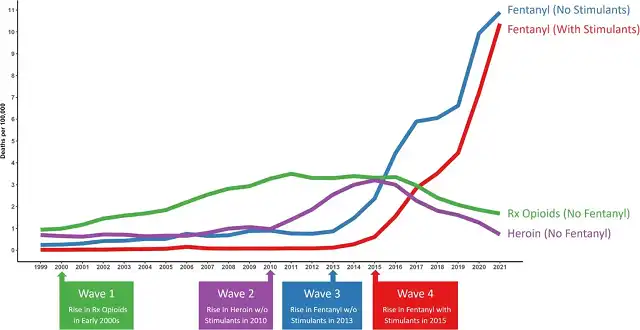Fentanyl and Stimulant Abuse Lead to the 4th Wave of Overdose Crisis
- Normal Liver Cells Found to Promote Cancer Metastasis to the Liver
- Nearly 80% Complete Remission: Breakthrough in ADC Anti-Tumor Treatment
- Vaccination Against Common Diseases May Prevent Dementia!
- New Alzheimer’s Disease (AD) Diagnosis and Staging Criteria
- Breakthrough in Alzheimer’s Disease: New Nasal Spray Halts Cognitive Decline by Targeting Toxic Protein
- Can the Tap Water at the Paris Olympics be Drunk Directly?
Fentanyl and Stimulant Abuse Lead to the 4th Wave of Overdose Crisis
- Should China be held legally responsible for the US’s $18 trillion COVID losses?
- CT Radiation Exposure Linked to Blood Cancer in Children and Adolescents
- FDA has mandated a top-level black box warning for all marketed CAR-T therapies
- Can people with high blood pressure eat peanuts?
- What is the difference between dopamine and dobutamine?
- How long can the patient live after heart stent surgery?
Fentanyl and Stimulant Abuse Lead to the 4th Wave of Overdose Crisis in the United States.
The latest research published in the scientific journal “Addiction” highlights a concerning trend: since 2010, the number of deaths in the United States due to overdosing on fentanyl and stimulants has increased by over 50-fold.
By 2021, stimulants were poised to dominate drug overdose cases related to fentanyl across various states in the United States. The “Fourth Wave” of the opioid overdose crisis presents numerous challenges for healthcare professionals, especially given the limited effectiveness of the commonly used antidote, naloxone.
A recent study reveals that cases of fentanyl-like stimulant overdoses in the United States have increased by 50-fold since 2010, marking the arrival of the “Fourth Wave” of the opioid crisis, with regional disparities and differences in drug combinations.
The latest research published in the scientific journal “Addiction” shows that since 2010, the proportion of overdose deaths involving fentanyl and stimulants in the United States has increased by more than 50-fold, rising from 0.6% (235 deaths) in 2010 to 32.3% (34,429 deaths) in 2021. By 2021, stimulants such as cocaine and methamphetamine had become the most common category of drugs involved in fentanyl-related overdoses in various states across the United States. The rising fatality rate from fentanyl/stimulants marks the “Fourth Wave” of the long-standing opioid overdose crisis in the United States, with deaths continuing to increase rapidly.
Expert Perspectives
Dr. Joseph Friedman of the University of California, Los Angeles, stated, “We are now witnessing the rapid emergence of fentanyl and stimulant use as the dominant forces in the U.S. opioid overdose crisis. Fentanyl is driving a poly-substance overdose crisis, meaning people are mixing fentanyl with other drugs like stimulants and countless other synthetic substances. This poses many health risks and new challenges for healthcare providers. While we have data and medical expertise in treating opioid use disorders, there is relatively less experience when it comes to opioid-stimulant co-use or opioid use in combination with other drugs. This makes it difficult to medically stabilize those who are trying to detox from multiple drug use.”

Image source:Addiction
People who consume multiple substances may also increase their risk of overdose, and many substances mixed with fentanyl do not respond to naloxone, the antidote for opioid overdoses.
Demographic Disparities
The authors also found that fentanyl/stimulant overdose deaths disproportionately affect minority racial/ethnic communities in the United States, including Black, African American, and American Indian populations. For example, in 2021, the rate of fentanyl-like stimulant overdose deaths among non-Hispanic Black or African American women aged 65 to 74 living in the western United States was 73%, while among non-Hispanic Black or African American men aged 55 to 65 in the same region, it was 69%. In contrast, this rate for the general U.S. population in 2021 was 49%.
Regional Drug Preferences
The use of fentanyl/stimulants also follows regional patterns. In the northeastern United States, fentanyl is often mixed with cocaine, while in the southern and western United States, fentanyl is most commonly mixed with methamphetamine. Friedman commented, “We suspect that this pattern reflects the widespread availability and increasing preference for low-cost, high-purity methamphetamine nationwide, and the entrenched pattern of illicit cocaine use in the northeastern region, which has not yet been fully displaced by methamphetamine in other parts of the United States.”
The analysis illustrates how the U.S. opioid crisis evolved from an increase in prescription opioids (First Wave) in the early 2000s and heroin (Second Wave) in 2010, with the surge in fentanyl overdose deaths around 2013 signaling the arrival of the Third Wave. The Fourth Wave, involving fentanyl-like stimulant overdoses, began in 2015 and continues to grow.
Fentanyl and Stimulant Abuse Lead to the 4th Wave of Overdose Crisis
(source:internet, reference only)
Disclaimer of medicaltrend.org
Important Note: The information provided is for informational purposes only and should not be considered as medical advice.



